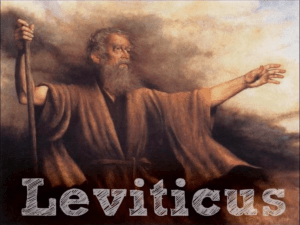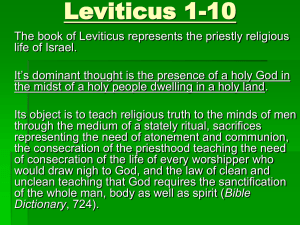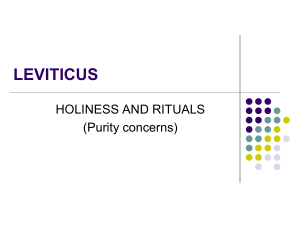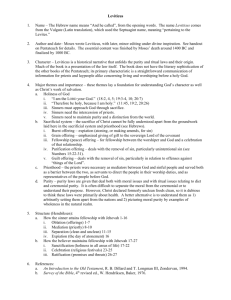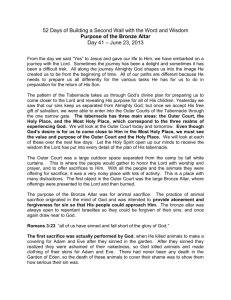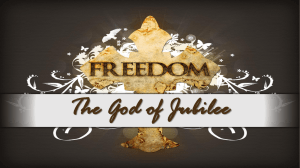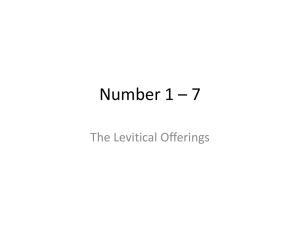Lesson 57 Leviticus 1-7 The Offerings Power Pt
advertisement
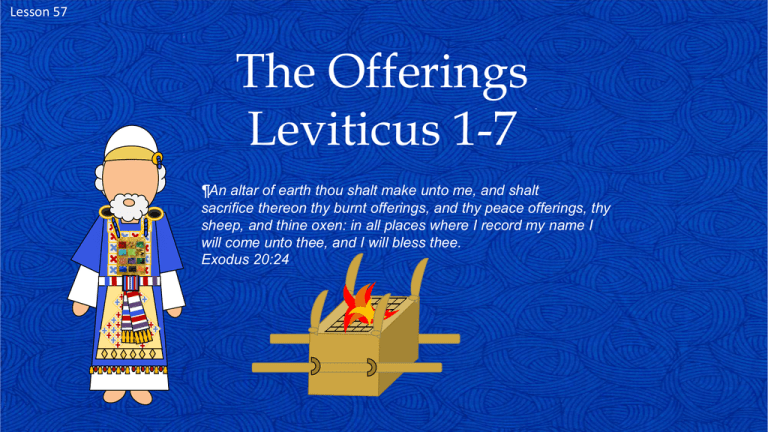
Lesson 57 The Offerings Leviticus 1-7 ¶An altar of earth thou shalt make unto me, and shalt sacrifice thereon thy burnt offerings, and thy peace offerings, thy sheep, and thine oxen: in all places where I record my name I will come unto thee, and I will bless thee. Exodus 20:24 What is the Book of Leviticus? “The Israelites had been led out of bondage and into a sanctuary and now they must move on from redemption to service; from deliverance to dedication.” “Leviticus is God’s guidebook for His newly redeemed people, showing them how to worship, serve and obey a holy God.” “It also contains eternal principles of the gospel which are familiar and very much applicable to everyone.” “It is basically a handbook for Hebrew priests and contains many rules, regulations, rituals, and ceremonies which seem strange and inapplicable to us.” Greek= in Septuagint, Leuitikon “that which pertains to the Levites” From this word—Latin = Leviticus which was adopted as the English title The Talmud refers to Leviticus as the “Law of the Priest,” and the Law of the Offerings.” (1,2) Who is the Author? External Evidence: Internal Evidence: 1. A uniform ancient testimony supports the Mosaic authorship of Leviticus 2. Ancient parallels to the Levitical system of trespass offerings have been found in the Ras Shamara Tablets dating from about 1400 B.C. and discovered on the coast of norther Syria 3. Christ ascribes the Pentateuch (which includes Leviticus) to Moses in Matthew 8:2-4 And Jesus put forth his hand, and touched him, saying, I will; be thou clean. And immediately his leprosy was cleansed. And Jesus saith unto him, See thou tell no man; but go thy way, shew thyself to the priest, and offer the gift that Moses commanded, for a testimony unto them. Matthew 8:3-4 This shall be the law of the leper in the day of his cleansing: He shall be brought unto the priest: Leviticus 14:2 Another evidence see: Matthew 12:4 and Lev. 24:9 1. 56 times in the 27 chapters of Leviticus it is stated that God imparted these laws to Moses. 2. The Levitical code fits the time of Moses. 3. Economic, civil, moral, and religious considerations show it to be ancient. 4. Many of the laws are also related to a migratory life-style. Leviticus picks up the story at this point and take place in the first month of the second year. Moses probably wrote much of Leviticus during that first month and may have put it in its final form shortly before his death in Moab, about 1405 B.C.. (1) Pentateuch A name given to the first five books of the Old Testament—Genesis, Exodus, Leviticus, Numbers, and Deuteronomy. The Jews refer to these books as the Torah or law of Israel. They were written by Moses And after they had given thanks unto the God of Israel, my father, Lehi, took the records which were engraven upon the plates of brass, and he did search them from the beginning. And he beheld that they did contain the five books of Moses, which gave an account of the creation of the world, and also of Adam and Eve, who were our first parents; 1 Nephi 5:10-11 (3) What are some of the sacrifices we make today Why are we expected to sacrifice so much as members of The Church of Jesus Christ of Latter-day Saints? The Priesthood Handbook Leviticus was a priesthood handbook for the children of Israel The Handbook provides instructions for administering priesthood quoarums and auxiliaries. It also provides instructions on Church programs, activites, leadership, and selected policies. Church Handbook of Instructions (3) Offerings The Offering Unblemished— without sin Christ The Priest Holy Ordained Mediator Christ The Offerer Man under the law Standing as a substitute Stand to meet God’s requirements Christ (4) The Priest The essential idea of a Hebrew priest was that of a mediator between his people and God by representing them officially in worship and sacrifice. By virtue of his office he was able to draw nigh to God, while they, because of their sins and infirmities, must needs stand afar off. The priest exercised his office mainly at the altar by offering the sacrifices and above all the incense but also by teaching the people the law by communicating to them the divine will and by blessing them in the name of the Lord (3) Special Restrictions For A Priest The priest does not take his office upon himself but is chosen of God In an especial sense he belongs to God and is holy to Him The priests must be Aaron’s sons and free from all important bodily blemishes or infirmities or diseases. Nothing is specified in the law as to the age at which a priest might begin to exercise his office. Levites were qualified according to the law at 30 or 25, and according to later usage at 20. Consecration to the priestly office consisted of two parts: ceremonial and sacrificial. They were under special restrictions with respect to uncleanness for the dead, marriage, wine or strong drink when engaged in sacerdotal duties. The ordinary universal prohibitions were specially binding on them; their families were under special and stricter laws, and liable to more severe punishments than the rest of the people. (3) Priest’s Ceremonial Functions (1) They were washed at the door of the tabernacle. The Three Sacrifices: (1) a bullock as a sin offering, to put away their sin; (2) They were clothed with the priestly garments (coats, girdles, and miters or turbans). (2) a ram as a burnt offering, to indicate the full and complete surrender of themselves to God; (3) They were anointed (Ex. 40:15) with holy oil. (3) a ram as a peace or consecration offering. The blood of the ram was put upon the tip of the priest’s right ear, the thumb of his right hand, and the great toe of his right foot. Obedience to the divine voice and activity in the divine service were thus symbolized. The priest’s hands were filled, “consecrated him”; Hebrew “filled his hand”) with the fat, the kidneys, the right thigh or shoulder, and part of the meal offering. The gifts that henceforward they would offer to the Lord on behalf of the people were thus committed to them. (1 Kings 13:33) (3) The Procedure—the Continual Burnt Offering 1. The Presentation His own personal act 6. The sacrificial meal (in the case of the peace offering only). The fat having been burnt and the priests’ pieces removed, the rest of the flesh was eaten by the sacrificer, his household, and the poorer Levites at the tabernacle. 2. The Laying on of hands (Lev. 16:21) Dedicated the animal to god and made it the sacrifice’s representative and substitute 3. The slaughtering of the animal At the north side of the altar Carried out the dedication to God that he had ceremonially expressed by the laying on of hands….later the custom was for the Levites or priests to slaughter the victims 4. The pouring out or sprinkling of the blood. 5. Burning the sacrifice on the altar. After the priest had properly prepared the sacrificial victim he offered it (the whole or the fat only) upon the altar of burnt offering. This act symbolized the consecration of the worshipper to Jehovah. (3) Burnt Offering blood round about upon the altar a male without blemish of his own voluntary will-served as a free expression of gratitude by the individual The Lord allowed for other kinds of animals to be used for burnt offerings, enabling the Israelites to offer acceptable sacrifices in conditions of poverty. Leviticus 1 flay … and cut it into his piece , and burn all on the altar. This sacrifice was performed at the tabernacle (and later at the temple in Jerusalem) every morning and evening, as well as on special occasions. The burnt offering got its Hebrew name from the idea of the smoke of the sacrifice ascending to heaven. The characteristic rite was the burning of the whole animal on the altar. (4) Meat or Meal Offering unleavened bread When burnt offering was completed it was given to the priests for their service and sustenance Leviticus 2 A meal offering was always given with the burnt offerings and peace offerings and could even substitute for a sin offering in the stress of poverty. (4) Peace Offering Male or female animal without blemish and cattle, sheep, or goats, but no fowl or other substitutes The fat and inward portions were burned upon the altar A means of giving thanks and asking for the Lord’s continued blessings. Unlike burnt offerings, portions of the peace offerings were eaten by those who had made the offerings (and their families), by the priests and their families, and by other Levites. Leviticus 3 A specified part was given to the priests and the remainder was used for meat in the special dinner (4) Sin Offering Male or female animal or fowl without blemish. Varied according to the position and circumstances of the offerer: Priests=young bullock Ruler of people=he-goat People in general=she-goat The poor= 2 turtledoves, or two young pigeons extreme poverty an offering of fowl or meal Leviticus 4-5, Exodus 30:10, Lev. 16:3,6,11, 15-19 Given for sins committed in ignorance sins not generally known about by the people sins in violation of oaths and covenants The purpose was to prepare for forgiveness and renewal of covenants A special sin-offering for all the people was offered on the Day of Atonement. All other sin offerings were private and personal offerings, most often given at the times of the appointed feasts. (4) And to offer a sacrifice according to that which is said in the law of the Lord, A pair of turtledoves, or two young pigeons. Luke 2:24 The command in Leviticus 12, in the Torah, is that a woman who bears a son must wait 40 days before she is considered pure. Then she can go to the temple and offer a sacrifice for sin. In Luke 2:24, we read that she offered a sacrifice according to what is said in the law of the Lord, “A pair of turtledoves or two young pigeons.” This might indicate they were a poor family, because the best possible sin offering was a lamb without spot or blemish. Marcia Carole And if it (a baby) be from a month old even unto five years old, then thy estimation shall be of the male five shekels of silver, and for the female thy estimation shall be three shekels of silver. Leviticus 27:6 (5) Horn of Salvation Jesus’ power to save The blood of the animal symbolized life or the Savior giving His life In the scriptures, the number four can represent the earth. Thus, placing blood on the horns could symbolize that there is power in the Savior’s Atonement to save all of God’s children who ever have or ever will live on the earth. Leviticus 4:5-7, 30 Luke 1:69 Trespass Offering Ram without blemish Nazarite and leper were to offer a lamb Trespass offerings were given for offenses committed against others: i.e., false testimony forceful and unlawful possession of property disrespect for sacred things, acts of passion. The offering was to bring forgiveness. This was possible after repentance and after fulfilling the law of restitution that required, where possible, that the guilty individual restore completely the wrong and an additional 20 percent All trespass offerings were private and personal offerings, most commonly given at the times of the appointed feasts. Leviticus 6 (4) Heave/Wave Offering The heave offering is the right shoulder and the wave offering the breast of the peace offering animal given in payment by the offerer for the services of the priest. This memorial offering was a type of peace or thank offering to the Lord, as well as a remembrance of God and service to Him. The Levites also received the hides of all the animals sacrificed for their labors and services. These were given at the times of burnt offerings and peace offerings. Leviticus 7 (4) “Certainly, the shedding of the blood of a beast could be beneficial to no man, except it was done in imitation, or as a type, or explanation of what was to be offered through the gift of God Himself—and this performance done with an eye looking forward in faith on the power of that great Sacrifice for a remission of sins” (6) ‘Real, personal sacrifice never was placing an animal on the altar. Instead, it is a willingness to put the animal in us upon the altar and letting it be consumed!’ “… When we overcome our own selfish desires and put God first in our lives and covenant to serve Him regardless of the cost, we are then living the law of sacrifice” (8) “After the Savior’s ultimate sacrifice, … the ordinance of the sacrament replaced the ordinance of sacrifice. … This change moved the focus of the sacrifice from a person’s animal to the person himself. In a sense, the sacrifice changed from the offering to the offerer. … “… Instead of the Lord requiring our animals or grain, now He wants us to give up all that is ungodly. … Elder Neal A. Maxwell of the Quorum of the Twelve Apostles said: ‘Real, personal sacrifice never was placing an animal on the altar. Instead, it is a willingness to put the animal in us upon the altar and letting it be consumed!’ (7) Sources: Suggested Hymn: #220 Lord, I Would Follow Thee Video: Christ is the Way (5:02) 1. Bruce Wilkinson and Kenneth Boa Talk thru the Bible pg. 20 2. Elder Ronald E. Poelman The Gospel and the Church November 1984 Ensign 3. Bible Dictionary 4. Old Testament Institute Manual 5. Marcia Carole Our Redemption Blog 6. (Teachings of Presidents of the Church: Joseph Smith [2007], 48 7. Elder M. Russell Ballard ‘Deny Yourselves of All Ungodliness’ Ensign, May 1995, 68). 8. Elder Neal A. Maxwell (“The Law of Sacrifice,” Ensign, Oct. 1998, 10). The Book of Leviticus Bible Dictionary Chapters 1-7 Chapters 8-10 Chapter 11 Chapters 12 Explains the sacrificial ordinances— the offerings Describes the ritual observed in the consecration of priests Explains what Discusses may or may women after not be eaten childbirth and what is clean or unclean Chapters 13-15 Chapter 16 Chapter 17-26 Chapter 27 Are laws relating to ceremonial uncleanness Contains the ritual to be observed on the Day of Atonement Contains a code of laws dealing with religious and social observances Explains that the Lord commanded Israel to consecrate their crops, flocks, and herds to the Lord Leviticus 1 Leviticus 2 Leviticus 3 Leviticus 4-5 Leviticus 6-7 Leviticus 7 Burnt Offering Meal Offering Peace Offering Sin Offering Trespass Offering Heave or Wave Offering Sinners are forgiven through sin offerings of animals without blemish—Priests thereby make an atonement for the sins of the people. Forgiveness comes through a trespass People must first make restitution for sin offer a trespass offering, and thereby gain forgiveness through atonement made by the priests. In payment by the offerer for the services of the priest A type of peace or thank offering to the Lord, as well as a remembrance of God and service to Him. Animals without blemish are sacrificed as an atonement for sins—Burnt offerings are a sweet savor unto the Lord. How offerings of flour with oil and incense are made. Peace offerings are made with animals without blemish, whose blood is sprinkled on the altar Sacrifice of Animals: Soon after Adam and Eve were cast out of the Garden of Eden, the Lord gave them the law of sacrifices, which included offering the firstlings of their flocks in a similitude of the sacrifice that would be made of the Only Begotten Son of God (Moses 5:4–8). Thereafter, whenever there were true believers on the earth, with priesthood authority, sacrifices were offered in that manner and for that purpose. This continued until the death of Jesus Christ, which ended the shedding of blood as a gospel ordinance. It is now replaced in the Church by the sacrament of the bread and the water, in remembrance of the offering of Jesus Christ. Sacrifices were thus instructive as well as worshipful. They were accompanied by prayer, devotion, and dedication, and represented an acknowledgment on the part of the individual of his duty toward God, and also a thankfulness to the Lord for his life and blessings upon the earth. Under the law of Moses, sacrifices were varied and complex, and a multitude of rules were given to govern the procedure, in keeping with the general character and purpose of the Mosaic law. Under the law offerings made to God must be the offerer’s own property, properly acquired (Lev. 1:3). Altar sacrifices were of three kinds: sin offerings, burnt offerings, and peace offerings. “In the clean animals, which he had obtained by his own training and care, and which constituted his ordinary live-stock, and in the produce obtained through the labour of his hands in the field and vineyard, from which he derived his ordinary support, the Israelite offered … the food which he procured in the exercise of his God-appointed calling, as a symbol of the spiritual food which endureth unto everlasting life [see John 6:27; 4:34], and which nourishes both soul and body for imperishable life in fellowship with God. … In this way the sacrificial gifts acquire a representative character, and denote the self-surrender of a man, with all his labour and productions, to God.” (Keil and Delitzsch, Commentary, 1:2:275–76.) The Priest’s Assignments: For the maintenance of the priests were assigned: (1) Portions of the Altar Offerings—namely, the whole of the sin and guilt offerings (except the fat), and the meal offerings, except the small portion burnt on the altar (Num. 18:9); the skin of the burnt offering (Lev. 7:8); the wave breast and the heave thigh of the peace offerings (Lev. 7:34). (2) The Firstfruits, especially of the seven products of Palestine (Deut. 8:8)—wheat, barley, oil, wine, figs, pomegranates, and honey; but also all kinds of fruits (Num. 18:13; Deut. 26:2); dough (Num. 15:20–21; Neh. 10:37); and the fleece of sheep (Deut. 18:4). There was also the heave offering, the gift of the best of the produce of the soil (Num. 18:12;Neh. 10:35, 37). (3) The Firstborn: the redemption money, in the case of man (five shekels, Num. 18:16), and unclean beasts (one-fifth more than the priest’s estimation, Lev. 27:27); and the clean beasts themselves (Num. 18:15–17). (4) The Tithe of the Levitical Tithe (Num. 18:26–28). (5) The Offerings. Some of these were given to the service of the Sanctuary, but things devoted were the priest’s (Lev. 27:21). (6) Certain cities (13 in number, all in Judah, Simeon, and Benjamin) with their suburbs; but the priests were to have no part or inheritance in the land (Num. 18:20; Josh. 21:13–19). Bible Dictionary Sin Offering According to Jewish law, Mary would have been required to bring a sin offering, after forty days, because of Jesus’ birth. You see, the command in Leviticus 12, in the Torah, is that a woman who bears a son must wait 40 days before she is considered pure. Then she can go to the temple and offer a sacrifice for sin. In Luke 2:24, we read that she offered a sacrifice according to what is said in the law of the Lord, “A pair of turtledoves or two young pigeons.” This indicates they are a poor family, because the best possible sin offering was a lamb without spot or blemish. in the Torah, had said first-born sons belonged to Him – to serve Him. Then, at a later point in history, one tribe (Levites) of Israelites became priests to serve God in the temple, so the system of “buying” back the first-born son was instituted. The parents of the firstborn males would come to the temple, and pay five shekels of silver to the Levites for their son, in a sense, buying their firstborn son back from the temple service. And the Levites would take this money and buy the things they needed to live and serve in the temple. Marcia Carole http://artengagingstory.com/category/our-redemption/


